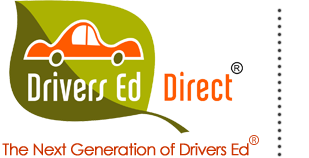Driving School How To - Vehicle Braking and Stopping
Here are some important things to remember when braking and stopping:
- Only use your right foot when braking and let your left foot relax.
- Unless there is an emergency, don't slam on your brakes. Smooth stopping is achieved by applying a gradual, gentle pressure to the brake pedal.
- Check your mirrors before you slow down or stop, making sure you are aware of traffic behind you.
- Never roll through stop signs. Always come to a full stop and do the proper left-right-left traffic checks while completely stopped.
- At stop signs and red lights, stop BEFORE the limit line and not on it! If there is no limit line painted, then stop before the crosswalk.
- When stopping behind another vehicle, make sure you can see their back tires touching the ground. This will ensure that you aren't too close to them and have room to maneuver in case you get rear-ended.
Braking and Stopping, Video Transcript
Hi! I'm Alejandra with Drivers Ed Direct and today we're going to learn all about braking and stopping.
So now we're going to discuss the pedals. We have the gas and the brake pedal. Now, the accelerator is on the far right side and the brake is on the left side. Now we only drive using our right foot. If we use both feet and accidentally step on both pedals at the same time, you can cause serious damage to your car and actually get into an accident. The emergency brake is found on the far left side of you. There's also a center lever or there's also a push-button.
When slowing down, you want to use your mirror just so that you are aware of what's behind you. If we slow down unexpectedly, the person behind us won't have enough time to react which can cause a rear-end collision.
Smooth stops are always safer because it's less of a chance of you getting rear-ended. It's better for the wear and tear on your brakes and tires and also more comfortable for your passengers. Examiners also love feeling smooth stops since they feel like you have better control of your vehicle.
So now that I explained to you the importance of braking smoothly, I'm going to show you how to attempt a smooth stop. The first step to slowing down is you want to ease your foot off the gas pedal and then cover the brake pedal. That way your car naturally starts to slow down by itself. Then you gradually put pressure on the brake and you'll notice I kept my heel planted and pivoted versus completely lifting my foot when moving between pedals. A common mistake seen with a lot of new drivers is they start slowing down a little too late which the result is at the end, there is a rough or abrupt stop. Now, a suggestion, the earlier you start slowing down, the smoother stops you get. When you see a red light up ahead, you know, why wait until the last minute? Ease your foot off the gas pedal and let the car naturally slow down so that way you end up with a smooth stop.
So when we're at a red light or a stop sign, you want to stop a couple of feet before the limit line. So basically, you stop right when the crosswalk or limit line disappears from view. Stopping on the limit line or over it can cause points off on the driving test, but if it gets to a point where we are completely blocking the intersection, then that can impede people's right-of-way which can cause an automatic fail. When stopping behind another vehicle, we want to make sure we don't stop too close. A very good trick that we teach a lot of our students is when we're slowing down, about to make a stop, you want to make sure we're able to see their back tires touching the pavement. That's how we know we have a good amount of space.
When stopping at a stop sign, it is very important to make full and complete stops, that way it gives you enough time to perform your traffic checks. Rolling through stop signs can cause automatic fails.
In a residential area, don't stop at an intersection that doesn't have a stop sign unless there is a pedestrian crossing or there is a hazard ahead. At intersections, at a green light, we want to make sure we avoid unnecessary stops because first of all, it's our right-of-way, and second, people behind us don't expect us to stop which can cause an accident as well.
Alright, let's do a quick recap of what we learned today. Remember, only use your right foot when braking, never your left foot. Never slam on the brakes unless it's an emergency. Instead, use a gentle gradual pressure just so that way the car can slow down in time. To avoid being rear-ended, make sure to check your rear-view mirrors before you start slowing down or stopping just so that way you are aware of traffic behind you. Always strive for the smoothest stops. Try to avoid abrupt stops or jolty stops. Remember to stop a safe distance before crosswalks and limit lines. When stopping behind other vehicles, we want to make sure we can at least see their back tires touching the pavement. Don't roll through stop signs. We want to make sure we make full and complete stops before the limit line. And finally, when in traffic, try to avoid stopping unnecessarily when you have the right-of-way. Hopefully, it goes well on the Drive test and I'll see you in the next video.

